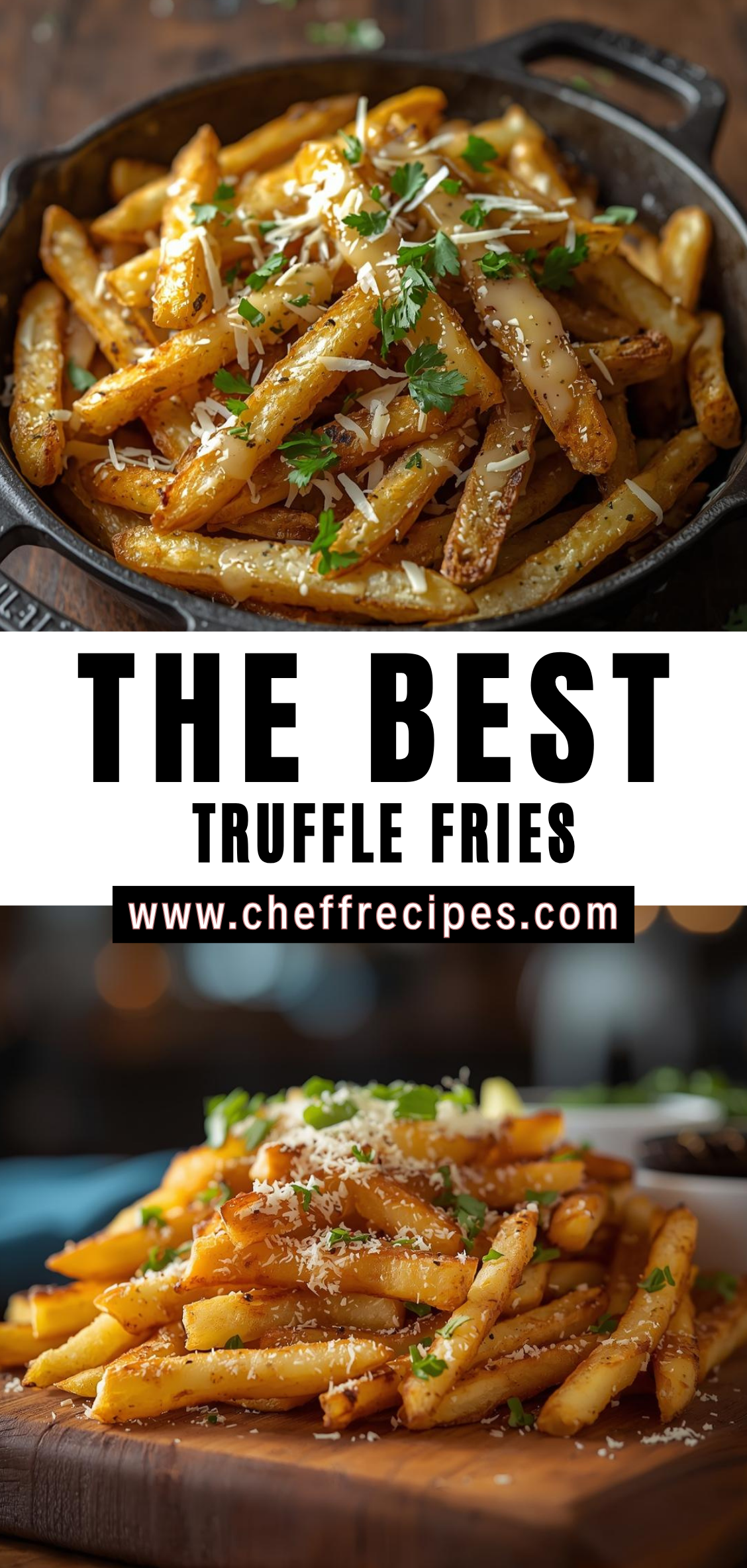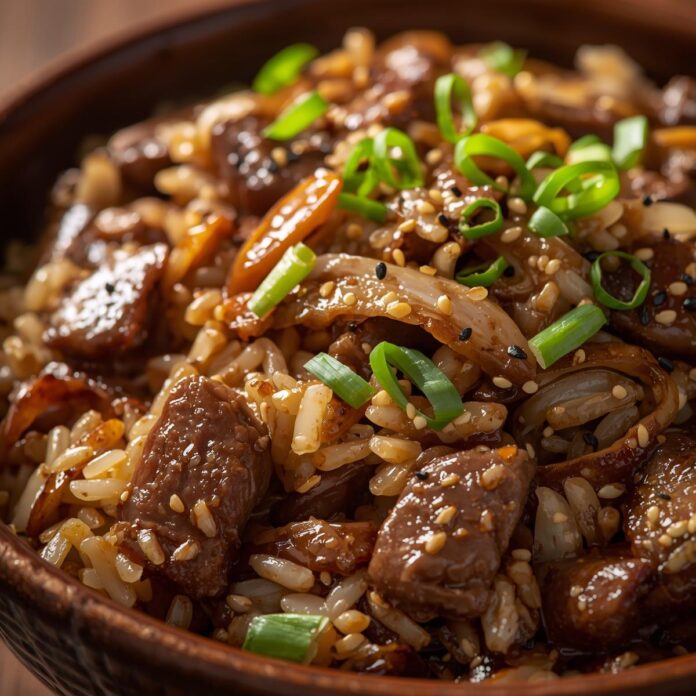Few culinary creations embody the marriage of comfort and luxury as elegantly as truffle fries. At first glance, they resemble something familiar and beloved—golden, crisp, perfectly salted French fries—but a single whiff reveals that this is no ordinary side dish. The intoxicating aroma of truffle oil—earthy, musky, and deeply aromatic—instantly transforms the experience. It’s a scent that evokes sophistication and indulgence, elevating something as humble as a potato into the realm of fine dining. The best truffle fries are not defined solely by the quality of their ingredients, but by the precise balance between texture, seasoning, and the ethereal perfume of truffle that lingers just long enough to captivate the senses without overwhelming them.

Truffle fries are, at their core, a paradox: the ultimate comfort food dressed in gourmet attire. They embody both the rustic charm of hand-cut potatoes sizzling in hot oil and the refined allure of truffle essence, a delicacy that has enthralled chefs and diners for centuries. The pairing seems almost accidental, even rebellious—a collision between street food simplicity and culinary opulence—but the result is a dish that feels inevitable. The crispy fry, with its satisfying crunch and fluffy interior, is the perfect vessel for truffle’s complex aroma. Add a sprinkling of sea salt, a handful of finely grated Parmesan, and a touch of fresh herbs, and what emerges is more than a snack—it’s an experience.
The story of truffle fries is as much about culinary evolution as it is about flavor. Classic French fries have long held an iconic place in global cuisine, their origins tracing back to the 18th century when fried potatoes first appeared in European kitchens. The truffle, by contrast, is ancient and rare—a subterranean fungus revered since Roman times, celebrated for its mysterious growth and intoxicating aroma. When the two finally met, sometime in the late 20th century amid the rise of modern gastronomy, the result was instant magic. Chefs began to see fries not as a humble side, but as a blank canvas for refinement, and truffle oil became the brush with which they painted. The dish’s popularity spread rapidly through upscale bistros, gastropubs, and tasting menus, eventually becoming a global symbol of approachable luxury.
But despite its ubiquity, truly great truffle fries remain elusive. The challenge lies in restraint and balance. Too much truffle oil, and the fries become cloying and artificial; too little, and the flavor disappears entirely. The texture of the fries must be impeccable—crisp on the outside, tender inside, with a clean bite that resists greasiness. The seasoning must be layered thoughtfully: a foundation of salt, an accent of Parmesan or pecorino, and perhaps the brightness of chopped parsley or chives to lift the richness. Every detail matters, from the type of potato to the choice of oil and the temperature of the fry. The best truffle fries are not an accident; they are the product of intention and precision.
To understand what makes truffle fries exceptional, one must first understand the truffle itself. Often called the “diamond of the kitchen,” truffles grow symbiotically among the roots of trees such as oak, hazel, and beech, hidden beneath the soil and discovered only with the help of trained dogs or pigs. Their rarity, coupled with the fleeting intensity of their flavor, has made them a symbol of culinary luxury for centuries. True truffles—whether the black Périgord from France or the white Alba from Italy—are delicate, seasonal, and astonishingly aromatic. Their essence is nearly impossible to replicate fully, yet truffle oils and salts, when used judiciously, can capture enough of that character to infuse a dish with unmistakable flair.
The modern truffle fry typically uses truffle oil, a blend of neutral oil infused with truffle aroma. While purists sometimes dismiss truffle oil for its synthetic notes, it remains a powerful tool in the home kitchen when handled correctly. The key is moderation and timing. Truffle oil should never meet high heat—it loses its aroma instantly when fried or baked. Instead, it should be applied after the fries are cooked, tossed gently while still warm so that the oil’s fragrance clings to the surface. When complemented by finely grated cheese and a scattering of herbs, the result is a sensory balance: salty, crispy, earthy, and fragrant, with just enough complexity to elevate a simple plate of fries into a restaurant-worthy dish.
There’s also an art to the cut and fry itself. The best truffle fries begin with the right potato—high in starch and low in moisture, such as the Russet or Maris Piper. The potatoes must be cut evenly to ensure uniform cooking, soaked to remove excess starch, and fried twice: first at a lower temperature to cook the interior, then at a higher temperature to crisp the exterior. This double-fry technique is what separates truly excellent fries from the merely adequate. It ensures that satisfying crunch with each bite, followed by the soft, pillowy center that contrasts beautifully with the assertive aroma of truffle.
Truffle fries are also a study in contrasts. They bring together rustic technique and luxury ingredient, simplicity and decadence, texture and aroma. They are best enjoyed hot, immediately after tossing—when the oil still glistens, the Parmesan melts slightly into the surface, and the truffle aroma envelops the air. Every bite becomes a layered experience: the initial saltiness, the buttery crispness of the fry, the savory tang of cheese, and finally that haunting, earthy whisper of truffle. It’s no wonder this dish has transcended its humble roots to become a staple of modern cuisine, found in steakhouses, wine bars, and Michelin-starred tasting menus alike.
And yet, for all its elegance, truffle fries are one of the most approachable gourmet dishes you can make at home. With the right ingredients and a little care, it’s entirely possible to recreate restaurant-level results in your own kitchen. The secret lies in mastering fundamentals—temperature control, oil management, seasoning precision—and finishing with restraint. Where many versions go wrong is in excess: too much oil, too much salt, too much cheese. True perfection comes from harmony. Each element should enhance the other, never dominate.
Detailed Instructions
Ingredient Preparation and Fundamentals
Truffle fries might appear simple—potatoes, oil, salt, and truffle essence—but every step leading to that perfect basket of crisp, aromatic fries depends on precision and respect for the process. The true art lies in understanding how each ingredient interacts with heat, oil, and aroma.
1. Selecting the Perfect Potato
The journey to great fries begins with choosing the right potato. Not all potatoes behave the same when fried. The best truffle fries start with a high-starch, low-moisture variety that crisps beautifully on the outside while remaining fluffy inside.
Recommended varieties:
-
Russet (Idaho) Potatoes: The classic choice, prized for their starch content and neutral flavor.
-
Maris Piper (UK/Europe): Equally suitable, with a light, airy texture.
-
Yukon Gold: Slightly less starchy but with a natural buttery note that pairs beautifully with truffle oil.
Why starch matters:
High-starch potatoes contain less water and more dry matter, which promotes crispness during frying. Lower-starch potatoes, like waxy red or new potatoes, tend to hold moisture and yield a softer, less crisp fry.
2. Washing and Soaking the Potatoes
Once peeled (optional, though peeled fries offer a cleaner texture), cut the potatoes into even sticks. The ideal size for truffle fries is about ¼-inch to ⅜-inch thick—substantial enough to hold their shape but thin enough to achieve a delicate crunch.
Steps:
-
Immediately after cutting, submerge the fries in a bowl of cold water.
-
Rinse and drain them several times until the water runs clear.
-
Soak for at least 30 minutes (or up to overnight in the refrigerator).
Why soak?
This step removes excess surface starch that can cause fries to stick together or brown unevenly. It also helps draw out some moisture, resulting in a crispier crust once fried.
Before frying, drain and dry the fries thoroughly on paper towels or a clean kitchen cloth. Excess moisture causes dangerous splattering and prevents proper crisping.
3. Preparing the Frying Oil
The frying oil determines not only texture but also flavor stability. Truffle fries require a neutral oil capable of withstanding high temperatures without breaking down.
Best choices:
-
Peanut oil: Classic for its high smoke point (about 450°F / 232°C) and clean flavor.
-
Canola or sunflower oil: Excellent neutral alternatives.
-
Avoid olive oil: Its low smoke point makes it unsuitable for deep frying.
You’ll need enough oil to submerge the fries completely, typically 2–3 inches deep in a heavy pot or deep fryer.
Pro Tip:
Use a deep, heavy-bottomed pan such as a Dutch oven or cast-iron pot to maintain consistent heat.
The Double-Fry Technique
The hallmark of exceptional fries—those that shatter slightly when bitten yet remain soft inside—comes from the double-fry method. This two-stage process builds structure and texture, ensuring a crisp exterior that stays that way long after seasoning.
1. The First Fry: Cooking the Interior
Temperature: 300°F (150°C)
Duration: 4–6 minutes
-
Working in small batches, lower the dried potato sticks carefully into the hot oil.
-
Fry until they turn pale and flexible but not yet browned.
-
Remove with a slotted spoon and drain on paper towels or a wire rack.
At this stage, the fries will look undercooked—but that’s intentional. The first fry cooks the interior gently, creating a soft, steamed center without toughening the exterior.
Why this matters:
Cooking at a lower temperature gelatinizes the starches inside the potato, forming a layer that will later crisp when refried. It’s a controlled pre-cook rather than a full fry.
Let the fries cool completely—preferably for at least 15–20 minutes or even chilled in the refrigerator for up to an hour. This cooling process allows steam to escape and surface moisture to evaporate, setting up the perfect conditions for the second fry.
2. The Second Fry: Achieving Crisp Perfection
Temperature: 375°F (190°C)
Duration: 2–4 minutes
-
Return the cooled fries to the oil in small batches.
-
Fry until golden brown and crisp, stirring gently to ensure even color.
-
Transfer immediately to paper towels or a rack to drain.
The difference between the two frying temperatures is what gives great fries their contrast: fluffy interiors and crisp, golden shells. The sound of frying—sharp and consistent—is a sign of success; bubbling that fades too quickly suggests the oil has cooled or absorbed moisture.
Pro Tip:
Maintain a consistent oil temperature. Adding too many fries at once lowers the heat, resulting in soggy fries.
The Truffle Finish
Once the fries are perfectly golden, timing becomes crucial. Truffle aroma is volatile—it dissipates quickly and can be lost if exposed to high heat or left uncovered for too long. The finishing steps should be swift, deliberate, and well-timed.
1. Preparing the Seasoning Mix
Before frying begins, prepare your seasoning so it’s ready for the hot fries. The best truffle fries rely on a balanced blend of salt, fat, and fragrance.
Base Seasoning:
-
1–2 tablespoons truffle oil (black or white, depending on preference)
-
1–2 teaspoons fine sea salt or truffle salt
-
¼ cup finely grated Parmesan or Pecorino Romano
-
1 tablespoon finely chopped fresh parsley or chives
Optional Enhancements:
-
A pinch of garlic powder or roasted garlic paste for a savory undertone
-
A dusting of freshly ground black pepper
-
For extra luxury: a few shavings of real black truffle
Note: Truffle oil varies in intensity; start with less and add more gradually. The goal is a delicate aroma, not an overpowering scent.
2. Tossing the Fries
When the fries emerge from their second fry, they should be hot, crisp, and slightly glistening. Transfer them immediately to a large mixing bowl.
-
Season while hot: Sprinkle with salt and toss gently to distribute evenly.
-
Add truffle oil: Drizzle lightly over the fries and toss again. The residual heat will help the oil cling to the surface without evaporating its aroma.
-
Add finishing touches: Sprinkle with Parmesan and herbs, tossing once more for even coating.
Pro Tip:
Use a wide stainless-steel bowl and toss with a gentle flicking motion rather than stirring. This ensures even distribution of oil and seasoning without crushing the fries.
Serving and Presentation
The final presentation of truffle fries should appeal to all senses—sight, smell, and texture.
Serving Temperature:
Serve immediately, while the fries are still hot enough for the cheese to melt slightly and the aroma of truffle fills the air.
Presentation Ideas:
-
Arrange the fries in a parchment-lined basket or ceramic bowl.
-
Top with an extra drizzle of truffle oil and a sprinkle of herbs just before serving.
-
Accompany with one or two dipping sauces such as:
-
Truffle Aioli: A creamy emulsion of mayonnaise, garlic, lemon juice, and a hint of truffle oil.
-
Parmesan Garlic Dip: Sour cream, minced garlic, and grated cheese blended smooth.
-
Smoked Paprika Ketchup: For contrast, a smoky-sweet sauce that highlights the fries’ earthy notes.
-
Pairing Suggestions:
Truffle fries complement a variety of dishes and beverages. They shine beside grilled meats, burgers, or steak, but are equally compelling with sparkling wines or champagne. The crisp acidity of sparkling wine cuts through the richness and amplifies the truffle aroma beautifully.
Technique and Troubleshooting
Even experienced cooks can encounter challenges when frying potatoes or using truffle products. Below are the most common pitfalls—and how to avoid them.
-
Fries turning soggy:
-
The oil temperature was too low. Ensure 375°F (190°C) during the second fry.
-
Overcrowding the pot cools the oil; fry in smaller batches.
-
-
Uneven browning:
-
Fries were different thicknesses or not dried properly before frying.
-
Stir gently during the second fry to maintain color uniformity.
-
-
Overpowering truffle flavor:
-
Too much truffle oil or poor-quality synthetic oil was used.
-
Always add truffle oil sparingly and use high-quality, real truffle-infused oil when possible.
-
-
No truffle aroma:
-
Truffle oil was added too early or to fries that were too hot.
-
Apply oil only after fries are fried and drained, not during cooking.
-
-
Fries not staying crisp:
-
Moisture in the air or from sauce can soften them. Serve immediately, and avoid covering them tightly.
-
Flavor Variations and Elevations
Once you’ve mastered the base technique, truffle fries can become a platform for creativity.
-
White Truffle Fries: Use white truffle oil and a sprinkle of sea salt; pair with a delicate Parmesan foam or aioli.
-
Black Truffle Fries with Mushroom Dust: Add powdered dried porcini or shiitake mushrooms for an extra earthy dimension.
-
Truffle Sweet Potato Fries: Substitute sweet potatoes for a sweet-savory contrast; balance with coarse salt and fresh thyme.
-
Loaded Truffle Fries: Add melted cheese, bacon crumbles, and scallions—luxury meets comfort.
Each variation retains the core principle of restraint: truffle should whisper, not shout.
The Best Truffle Fries
Few culinary creations embody the marriage of comfort and luxury as elegantly as truffle fries. At first glance, they resemble something familiar and beloved—golden, crisp, perfectly salted French fries—but a single whiff reveals that this is no ordinary side dish. The intoxicating aroma of truffle oil—earthy, musky, and deeply aromatic—instantly transforms the experience. It’s a scent that evokes sophistication and indulgence, elevating something as humble as a potato into the realm of fine dining. The best truffle fries are not defined solely by the quality of their ingredients, but by the precise balance between texture, seasoning, and the ethereal perfume of truffle that lingers just long enough to captivate the senses without overwhelming them.
Ingredients
- 2 large russet potatoes (or about 1½ pounds), scrubbed and peeled (optional)
- 2 tablespoons truffle oil (white or black, high-quality)
- 2 tablespoons finely grated Parmesan cheese
- 1 tablespoon finely chopped fresh parsley
- 1 teaspoon garlic powder (or 2 cloves minced garlic, sautéed in a bit of oil)
- Salt and freshly ground black pepper, to taste
- Vegetable oil (for frying) or cooking spray (for baked version)
Instructions
1. Prepare the Potatoes
- Cut potatoes into thin fries (¼-inch thick).
- Soak the fries in cold water for at least 30 minutes (up to 2 hours) to remove excess starch — this helps them get crispy.
- Drain and pat very dry with paper towels.
2. Frying Method (Crispiest)
- Heat oil in a deep fryer or heavy pot to 325°F (165°C).
- Fry the potatoes in small batches for 3–4 minutes until just tender but not browned. Remove and drain.
- Increase oil temperature to 375°F (190°C).
- Fry again for 2–3 minutes, or until fries are golden and crisp.
- Drain on paper towels and immediately season with salt.
3. Baking or Air Fryer Option
- Baking: Toss dried fries with 1–2 tablespoons vegetable oil, spread in a single layer on a baking sheet, and bake at 425°F (220°C) for 25–30 minutes, flipping halfway.
- Air Fryer: Cook at 380°F (193°C) for 18–20 minutes, shaking halfway through.
4. Add the Truffle Finish
- While fries are still warm, drizzle with truffle oil and toss gently to coat evenly.
- Sprinkle with Parmesan cheese, parsley, garlic powder, and black pepper.
- Toss again lightly and taste — add a pinch more salt if needed.
Serving Suggestions
Serve immediately with:
- Truffle aioli (mix mayo, lemon juice, minced garlic, and a few drops of truffle oil)
- Garlic Parmesan dip
- Ketchup or spicy aioli for a simple pairing
Notes
- Use truffle oil sparingly — it’s potent! Start with 1 tablespoon and adjust to taste.
- Black truffle oil has a more earthy, musky flavor, while white truffle oil is lighter and garlicky.
- For extra decadence, shave a bit of real truffle or drizzle melted truffle butter on top.
- Fries are best served immediately; they lose crispness as they sit.



